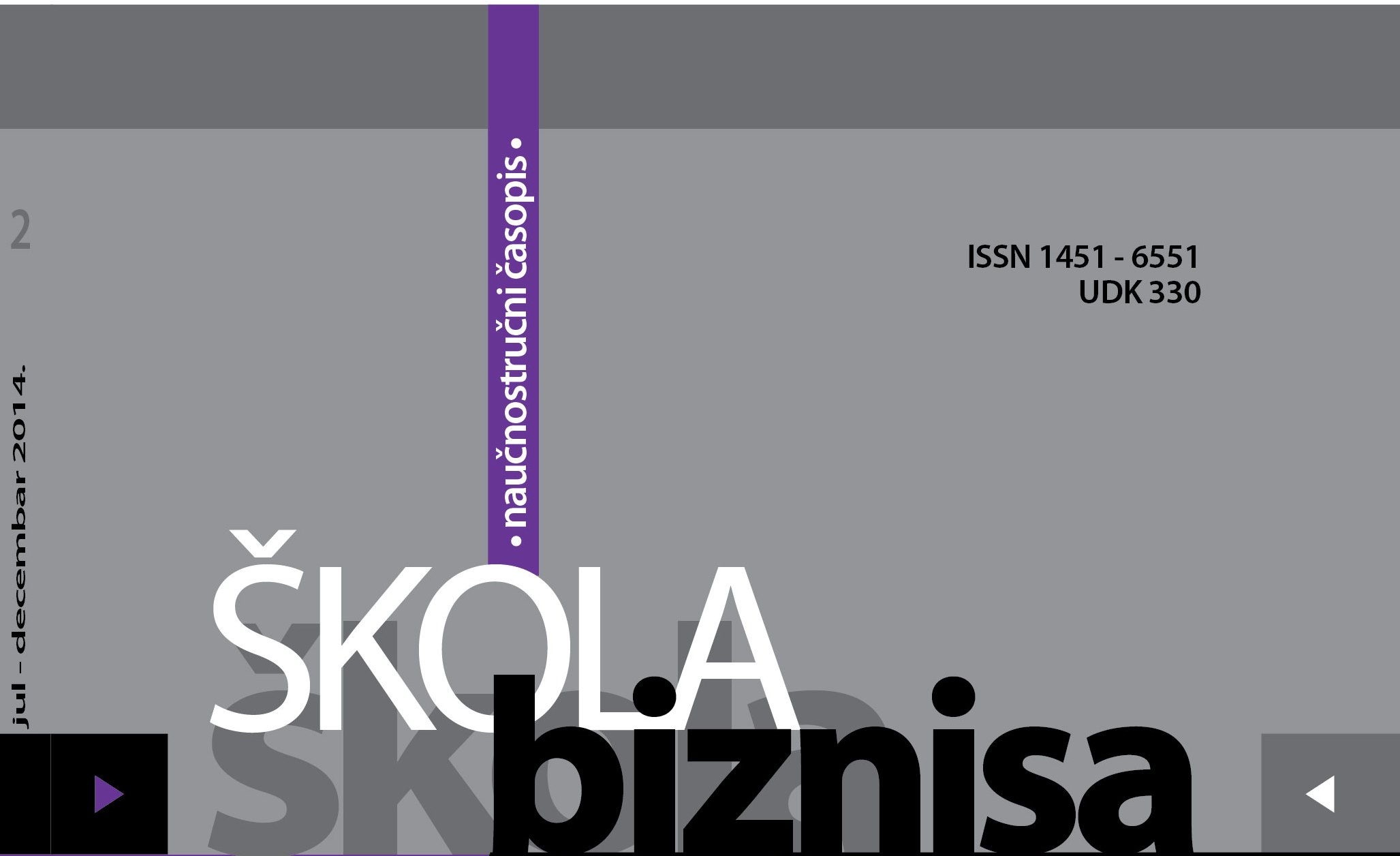CONSUMER LOYALTY IN RETAILING
Abstract
Loyal consumers are partner enterprises and they represent stable source of income. Companies are more interested in maintaining the existing consumers, rather than attracting the newones, because loyal consumers are the most valuable asset. The aim of this article is to develop an integrative conceptual framework for creating and maintaining consumer loyalty, and ,at the same time, to be based on a thorough review of the relevant literature and the current market situation . In this context, empirical research was carried out by using the survey method on a random sample of 165 respondents. Based on the research conducted, important factors that influence consumer loyalty were identified.
References
Asubonteng, P., McCleary, K. J., & Swan, J. E. (1996). SERVQUAL revisited: a critical review of service quality. Journal of Services Marketing, 10(6), 62–81.doi:10.1108/08876049610148602.
Berger, P. D., & Nasr, N. I . (1998). Customer lifetime value: Marketing models and applications. Journal of Interactive Marketing, 12(1), 17–30. doi:10.1002/(sici)1520-6653(199824)12:1<17::aid-dir3>3.0.co;2-k.
Brody, R. P., & Cunningham, S.M. (1968). Personality Variables and the Consumer Decision Process. Journal of Marketing Research, 5(1), 50–57. doi:10.2307/3149793.
Brown, G. H. (1952). Brand loyalty – Fact or fiction. Advertising Age, 23, 53–55.
Cunningham, S. M. (1966). Brand loyalty – What, where, how much. Harvard Business Review, 34, 116–128.
Dabholkar, P. A. (1996). Consumer evaluations of new technology-based self-service options: An investigation of alternative models of service quality. International Journal of Research in Marketing, 13(1), 29–51. doi:10.1016/0167-8116(95)00027-5.
Dick, A. S., & Basu, K. (1994). Customer Loyalty: Toward an Integrated Conceptual Framework. Journal of the Academy of Marketing Science, 22(2), 99–113. doi:10.1177/0092070394222001.
Dowling, G. R., & Uncles, M. (1997). Do customer loyalty programs really work. Sloan Management Review, 38(4), 71–82.
Duwors, R. E., & Haines, G. H. (1990). Event History Analysis Measures of Brand Loyalty. Journal of Marketing Research, 27(4), 485–493. doi:10.2307/3172633.
Farley, J. U. (1964). Why does brand loyalty vary over products. Journal of Marketing Research, 1(4), 9–14. doi:10.2307/3150371.
Field, A. (2000). Discovering statistics using SPSS for Windows. USA: Sage Publication.
Grönroos, C. (1984). A Service Quality Model and its Marketing Implications. European Journal of Marketing, 18(4), 36–44. doi:10.1108/eum0000000004784.
Gwinner, K. P., Gremler, D.D., & Bitner, M.J. (1998). Relational Benefits in Services Industries: The Customer’s Perspective. Journal of the Academy of Marketing Science, 26(2), 101–114. doi:10.1177/0092070398262002.
Herschell, L.G. (1997). Does your “loyalty” program inspire any loyalty. Direct Marketing, 46–48.
Hughes, A. M. (1996). The complete database marketer, 2nd. New York: McGraw-Hill.
Kahn, B. E., Kalwani, M. U., & Morrison, D. G. (1986). Measuring Variety- Seeking and Reinforcement Behaviors Using Panel Data. Journal of Marketing Research, 23(2), 89–100. doi:10.2307/3151656.
Khare, A., Parveen, C., & Rai, R. (2010). Retailer behavior as determinant of service quality in Indian retailing. Journal of Retail and Leisure Property, 9(4), 303–317. doi:10.1057/rlp.2010.14.
Liddy, A. (2000). Relationship marketing, loyalty programmes and the measurement of loyalty. Journal of Targeting, Measurement Analysis for for Marketing, 8(4), 351–362.
Liebermann, Y. (1999). Membership Clubs as a Tool for Enhancing Buyers’ Patronage. Journal of Business Research, 45(3), 291–297. doi:10.1016/s0148-2963(97)00241-5.
Mägi, A. W. (2003). Share of wallet in retailing: the effects of customer satisfaction, loyalty cards and shopper characteristics. Journal of Retailing, 79(2), 97–106. doi:10.1016/s0022-4359(03)00008-3.
Marinković, V. (2012). Marketinški aspekti satisfakcije i lojalnosti: Orijentacija na potrošače u savremenom bankarskom poslovanju. Kragujevac: Ekonomski fakultet.
Marinković, V., & Senić, V. (2012). Analiza elemenata kvaliteta usluga u korporativnom bankarstvu. Ekonomski horizonti, 14(1), 13–22. doi:10.5937/ekonhor1201013m.
Meng, J., Summey, J.H., Herndon, N.C., & Kwong, K.K. (2009). On the retail service quality expectations of Chinese shoppers. International Journal of Market Research, 51(6), 773–796. doi:10.2501/S1470785309200967.
Nunnally, J. C. (1978). Introduction to Psychological Measurement. New York: McGraw-Hill.
Parikh, D. (2006). Measuring Retail Service Quality: An Emprirical Assessment of the instrument. The Journal of Decision Makers, 31(2), 45–55.
Passingham, J. (1998). Grocery retailing and the loyalty card. Journal of Market Research Society, 40, 55–63.
Reddy, R. V., Reddy, N., & Azeem, A. B. (2011). Influence of Store Satisfaction, Merchandise Quality, andService Quality on Store Loyalty. International Journal of Trade, Economics and Finance, 2(5), 351–355. doi:10.7763/ijtef.2011.v2.130.
Reichheld, F. F. (2003). The one number you need to grow. Harvard Business Review, 81(12), 46–54. pmid:14712543.
Reinartz, W. J., & Kumar, V. (2000). On the Profitability of Long-Life Customers in a Noncontractual Setting: An Empirical Investigation and Implications for Marketing. Journal of Marketing, 64(4), 17–35. doi:10.1509/jmkg.64.4.17.18077.
Srivastava, R. K., Shervani, T. A., & Fahey, L. (1998). Market-Based Assets and Shareholder Value: A Framework for Analysis. Journal of Marketing, 62(1), 2–18. doi:10.2307/1251799.
- Authors retain copyright and grant the journal right of first publication with the work simultaneously licensed under a Creative Commons Attribution License that allows others to share the work with an acknowledgement of the work's authorship and initial publication in this journal.
- Authors are able to enter into separate, additional contractual arrangements for the non-exclusive distribution of the journal's published version of the work (e.g., post it to an institutional repository or publish it in a book), with an acknowledgement of its initial publication in this journal.
- Authors are permitted and encouraged to post their work online (e.g., in institutional repositories or on their website) prior to and during the submission process, as it can lead to productive exchanges, as well as earlier and greater citation of published work (See The Effect of Open Access).

